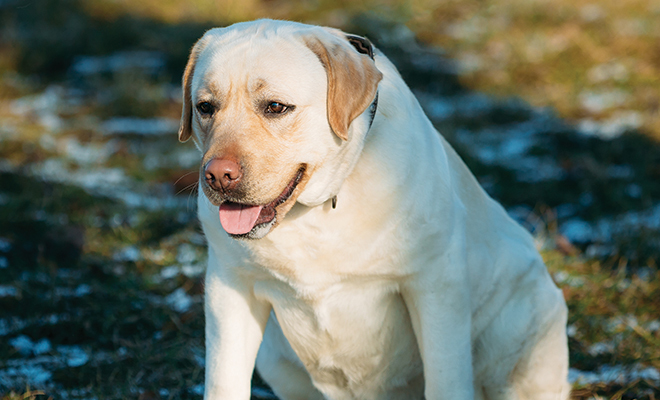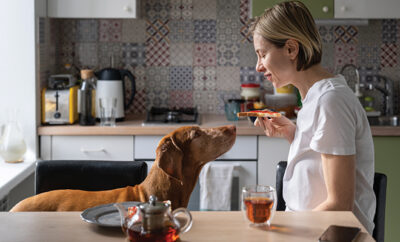
Helping Your Pet Battle the Bulge
Loosely translated, he was raising his eyebrows at me to suggest that perhaps I was giving my dog one treat too many on occasion. Guilty as charged. But can you blame me? That sweet face. Those adorable eyes. That cute little whimper begging for a bite of my sandwich. “I, too, like ham sandwiches,” is what his begging countenance seems to convey to me.
My kids joke that if there is a pet around the house, it will be living large, and not in a good way. I tend to overfeed my pets because I think treats equal love. Now, it is not as bad as you might think. I am exaggerating for comedic effect, yet there is some truth to my actions. I need to come to grip with reality. My dog needs to go on a diet. He is older now and walks with a limp, so going on long walks around the neighborhood is out of the question. Cutting back on the treats will require more discipline on my part than on his. Getting an out-of-shape pet back into shape can be a challenge, but it’s not impossible.
Experts observe that more than half of the nation’s dogs and cats are overweight. This can lead to a risk of developing arthritis, diabetes, kidney and heart disease, along with high blood pressure and many forms of cancer. Is that extra treat worth it? As challenging as it might seem, it is easier than you might think to help your pet lose weight.
Calculate calories. If you are unaware of your pet’s daily caloric needs, then how can you know how much to feed him? It’s not always wise to trust the feeding guidelines on the bag, either. Ask your veterinarian to calculate the proper amount of calories your pet needs daily. A good formula for this is to divide your pet’s weight by 2.2. Then multiply this figures times 30. Finally, add 70 and you have a general idea as to how many calories your pet should consume daily. Clearly, each pet’s metabolism is different, which is why you should get a veterinarian’s recommendation before starting your pet on a diet.
Get a measuring cup. That will be one of your greatest tools in battling the bulge. You can’t just fill the bowl or guess how much your pet needs. Keeping the bowl continually full for an all-day buffet won’t cut it, either. The Association for Pet Obesity Prevention has conducted studies that indicate just ten extra nibbles of kibble per day can add up to a pound of weight gain per year in both indoor cats and small dogs. Once you have determined how many calories your pet needs, you can accurately measure how much to give him at each meal.
Treats are fine, but beware the empty calorie ones. If you want to give your pet an extra goodie, make sure it is nutritious and not filled with sugar and fat. Defer to single-ingredient treats, such as sweet potato, salmon and blueberry bites. Not only are these treats healthy, they also help to keep your pet’s teeth clean and promote mobility. Whenever giving treats, however, be sure to factor in those additional calories to your pet’s overall daily intake. If you feed the proper amount of food but fail to include the calories in the treats, then you’re sabotaging your efforts. Just 30 extra calories a day can add up to a three-pound weight gain in your pet over the course of a year.
Daily exercise is an important part of the health equation as well. Aim for 20 to 30 minutes a day of brisk walking. This will increase immune function and improve cardiovascular health in your pet. You may notice a few benefits in your own health, too!
Ultimately, keeping your pet’s health and weight in check is your responsibility. Your pet cannot take charge of his life and relies on you to do what’s best for him. Additionally, it’s important to obtain the cooperation of everyone in the household in order to make your efforts successful. Beware of that one person in your family who feels sorry for your pet and secretly offers him a little treat. What that person can do instead is to play with the pet or take him on a walk. Any type of exercise is far better than none.
As you help your pet with a diet, you are giving him the gift of a longer, healthier and more enjoyable life. With any change in diet, however, please ask your veterinarian about the best approach for your dog. Certain underlying conditions could require a different dietary approach. ■
Sources: pethealthnetwork.com and petmd.com.







